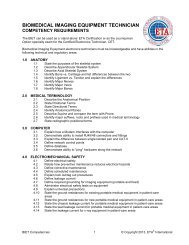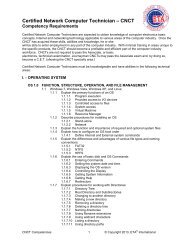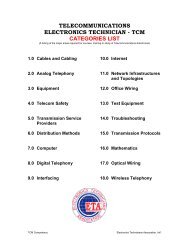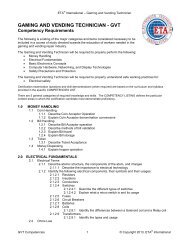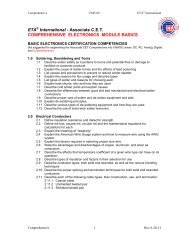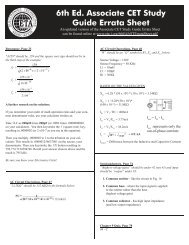Create successful ePaper yourself
Turn your PDF publications into a flip-book with our unique Google optimized e-Paper software.
each solar module. With the trend toward smaller (business and residential) installations, micradvantages. First, each solar module MPPT can be optimized, which elevates the overall arrayinverters appear to be more cost effective. Micro-inverters (Fig. 8) offer a number ofperformance. Second, central inverters are not required, which lowers system cost in terms ofSecond, high levels of DC voltages are dangerous and DC maximum of 600 V. Further, the NEC 2008 requirement toinstallation expenses. Third, the array ac output voltage can range from 200-300 VAC, whichswitch gear (Fig. 5) are not as common as AC switch gear. compensate array high DC voltage levels for cold temperatureswell below the NEC 2008 maximum of 600 V. Further, the NEC 2008 requirement toProfessor Daniel Kammen, a professor of public policy specializingin energy at the University of California, Berkeley, creasing temperatures experienced by micro-inverters will beis eliminated. The increase in the module DC voltage with de-compensate array high DC voltage levels for cold temperatures is eliminated. The increase in tmodule DC voltage with decreasing temperatures experienced by micro-inverters will be far lesays that the solar industry has held on to the convention of far less as they operate on inputs around 30 VDC. The microinverterscan inherently compensate for cold temperature con-as they operate on inputs around 30 VDC. The micro-inverters can inherently compensate forconnecting solar panels in a string since the 1960s, when inverterswere expensive. "It's sort of crazy that we still hookcold temperaturesolarditionsconditionsto provideto providea constanta constantACACoutput.output.panels together in series," Kammen says. "You take what'snow the most expensive part of the system, the solar panels,and just by the way you string them together you cut downtheir output." Solar modules are placed in series to ensurethe central inverter(s) receive an adequate dc input voltage.Raising the voltage reduces the current needed to supply agiven power level. However, the NEC limits the voltage to600 V maximum for single family residences and duplexes.Since the open-circuit voltage of solar modules increases asthe temperature decreases, NEC 2008, Article 690, whichcovers photovoltaic systems, provides Table 690.7. This tablegives open-circuit voltage correction factors for low-temperatureFigure 8. (Courtesy of Enphase Energy – www.enphaseenergy.com)conditions based on the historical temperature data The Magnificent Eight - Micro-inverter Companiesfor a particular location.The Magnificent There appears Eight to - Micro-inverter be a “gold rush” Companiesmentality to this new systemto be architecture. a “gold rush” mentality It is clear to this that new distributing system architecture. the conversion It is clear thatThere appearsThird, the inverter (Fig. 5) must handle all of the ac distributing power, the process conversion to each process module to each makes module the makes entire the entire solar solar power power system system moreforms a system single-point failure, and provides maximum productive, reliable, more productive, and smarter than reliable, traditional and inverter smarter systems. than traditional Eight companies invert-haverseveral systems. have apparently Eight companies to have started have in appeared 2009! The –“eight” and several via the Internet arpower point tracking based on the weakest array elements. appeared – andThe inverter is one of the heaviest system elements, which have apparently to have started in 2009! The “eight” via themeans its associated Balance of System (BOS) components Internet are: Accurate Solarand installation time is significant. From Fig. 5 it is clear thatif the inverter stops working, the entire system is down.Accurate Array Solar ConverterArray Enecsys ConverterEnecsys EnphaseTo improve array performance, maximum power point tracking(MPPT) is used in the central inverter(s). An algorithm isemployed in the software used to control the inverter’s (internal)microcontroller.Enphase eIQEnergyeIQEnergy GreenRay SolarGreenRay Petra SolarPetra Solar BridgeSolar BridgeBasically, the array current is increased and the power is measured.The algorithm continues to raise the current. The curtiesshippingthe leader apparent is Enphase. product-shipping Many of the new companies leader seem to be is following Enphase. the Enphase Many lead ofWhile many of the listed companies suggest talent and possibili-Lilliputian Inverters While Slay many Array of the listed Problems companies suggest talent and possibilities, the apparent product-Pagrent will continue to increase until a decrease in the power is the(Fig.new9).companies seem to be following the Enphase lead (Fig. 9).detected. Hence, maximum array output power is achieved.The problem with this approach is the MPPT for the arrayis not obtained, but will find a local maximum. The centralinverter(s) are dealing with an array of varying modules.Consequently, the algorithm result will be dominated by theperformance of one panel that performs poorly. Again, theweakest module in series dominates. In practice we just cannotcount on well-matched modules.Micro-invertersAs mentioned previously, MPPT array optimization is not likelythrough the use of central inverters (like the Sunny Boy 2100U).However, small (200-500W) inverters can be installed by eachsolar module. With the trend toward smaller (business andresidential) installations, micro-inverters appear to be morecost effective. Micro-inverters (Fig. 8) offer a number of advantages.First, each solar module MPPT can be optimized,which elevates the overall array performance. Second, centralinverters are not required, which lowers system cost in termsof installation expenses. Third, the array ac output voltage canrange from 200-300 VAC, which is well below the NEC 2008Figure 9. (Courtesy of Enphase Energy – www.enphaseenergy.com)The micro-inverters are installed on the racking underneath each solar module. The inverterare installed on the racking underneathoutputs are connected is parallel. The array output is an AC voltage rather than DC and the ACeach voltage solar ranges from module. 200 to 300 VAC. The Each inverter module also transmits outputs performance are connected data using the isparallel.AC wiring.The array output is an AC voltage rather than DCand Enphase the also AC provides voltage a communication ranges gateway from (Fig. 200 10) that to plugs 300 into VAC. a regular AC Each outlet. modulealso transmits performance data using the AC wiring.The communication gateway uses a standard Ethernet router to send the performance data to theEnphase website.Enphase also provides a communication gateway (Fig. 10)that plugs into a regular AC outlet. The communication gatewayuses a standard Ethernet router to send the performancedata to the Enphase website.6 | The <strong>High</strong>-<strong>Tech</strong> News | JAN/FEB2010



